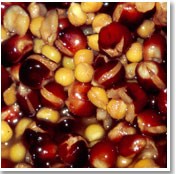If, like me you fish more long sessions of a week or more than you do day or weekend sessions, then you may like to try this tip for preparing particles at the lakeside. Though some folks think that a particle such as maize, for instance, can be prepared simply by soaking it in lake water, this is simply not the case. Every particle should be soaked AND cooked in order to prepare it safely. However, on long sessions cooking large amounts of grains or pulses by the water’s edge can cause problems
The secret of successful bait preparation at the water’s edge is a pressure cooker. Normally, water boils at a temperature of 100 degrees C (212 degrees F).This temperature is controlled by atmospheric pressure and cannot increase, no matter how long boiling continues. However, if the atmospheric pressure can be increased, the temperature at which liquids boil can be raised accordingly. This is the basic principle behind pressure cooking, where the ingredients to be cooked and the liquids they are cooked with are enclosed in a steam-proof vessel; the steam, which goes freely away into the atmosphere from a normal saucepan, is allowed to escape only under pressure, so raising the temperature. Being under pressure, it is forced through the food, cooking and tenderising it at the same time.
With most pressure cookers, the atmospheric pressure can be altered to give three different cooking temperatures. This is done by using different combinations of weights, so that each food can be cooked at the pressure and temperature that gives the best results in the shortest possible time. I tend to use all three weights when cooking particles such as maize. Because of the way a pressure cooker forces steam through the bait, dried particles can even be cooked in a pressure cooker without the need for pre-soaking. However I still like to give my baits a quick 4-hour soak just to be on the safe side.
The great advantage of using a pressure cooker on the bank is the amount of bait you can produce in a relatively short time. Using high power burners like my decrepit but very powerful Coleman double burner it is possible to cook 10 kilos of say red maize in about an hour.
It is important to follow the instructions when using a pressure cooker. Here are a few of the most important ones.
1. Always err on the generous side when adding water to the cooker. Never use any liquid that does not turn into steam when it boils.
2. Put on the cover, lining up the two arrows on the top section (the cover) and the lower section (the pan). Slide the cover’s handle to the left until it is over the base handle. If this proves difficult, firmly press the top of the cover opposite the handle and try again.
3. Place the correct weight on the center vent, pushing down until a slight click is heard.
4. Put the cooker on a high heat and wait until there is a slight hissing followed by a much louder one as steam escapes. Do not leave the cooker during this period, as the heat should be reduced as soon as pressure is reached to prevent loss of liquid and the possibility of the cooker boiling dry. A continuous loud hissing indicates that the cooker has been brought to pressure. Begin timing from this moment and reduce the heat immediately until a gentle hissing is heard. Some adjustment of the heat may be necessary to maintain the gentle hissing throughout cooking. Drops of water around the center vent before or during pressure cooking do not indicate that anything is wrong.
5. Once the cooking time is up, pressure must be reduced before the cover can be removed. NEVER ATTEMPT TO REMOVE THE WEIGHT UNTIL THIS HAS BEEN DONE. There are two ways of doing this. The first is by standing the cooker in cold water – the lake margins for instance – but make sure water cannot enter the safety plug or runs into the center vent. The second way is simply to allow the pan and contents to cool normally. Cooking will continue for some time after the cooker has been taken off the heat.
6. To test if the pressure has been reduced, gently lift the top weight and tip it to the side. If steam comes out the pressure is still built up inside the cooker. When no more steam comes out the cover can be removed. NEVER ATTEMPT TO REMOVE THE COVER IMMEDIATELY AFTER ROMOVING FROM THE HEAT.
7. I tend to cook about 2.5kg of soaked particles at a time, always ensuring that there is enough water to cover them by about an inch. As a rule of thumb baits such as standard maize, red maize and mini-maize take about 10 minutes to cook once they come to the boil. Tiger nuts cook in about 20 minutes. Hempseed is best cooked for about 15 minutes. Micro seed blends such as Red Band® take about 5 minutes.
(To illustrate this article I have used red maize with a few grains of standard maize throw in for good measure.)
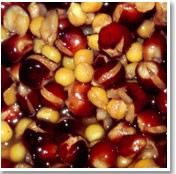
First soak the particle in a carp sack left in the margins for about 4 hours.
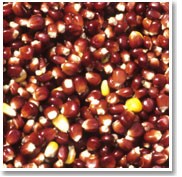
Now transfer the particle from the sack to the pressure cooker.

Add the required amount of lakewater. This will depend on the amount of bait you are cooking but make sure the water covers the top of the bait by at least 2cm. Put on the lid with the weights in place and make sure it is securely fastened.
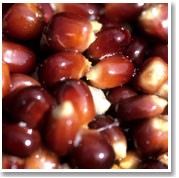
After the particle has been cooked it is a good idea to introduce it while still hot.
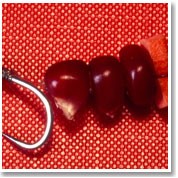
For a bit of variety why not mix two particles together. This is red maize and mini-maize.

Three grains of red maize on a simple rig will do the business.
Written by Ken Townley

